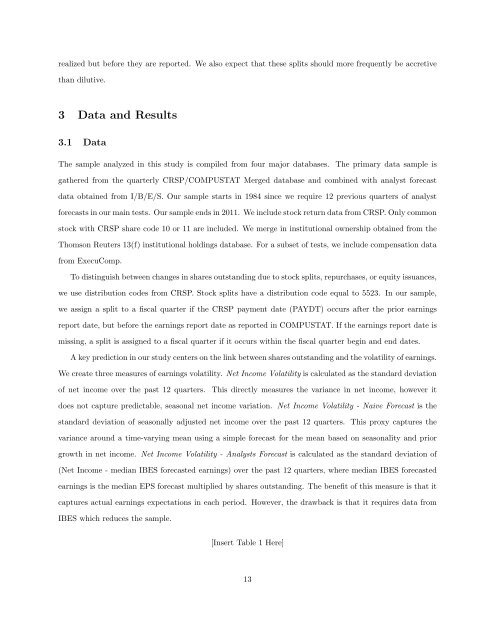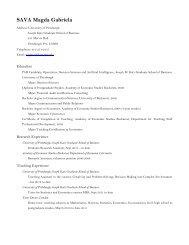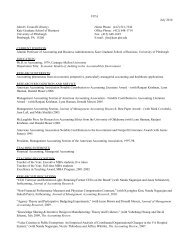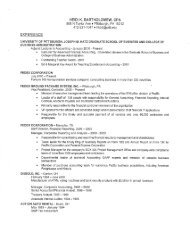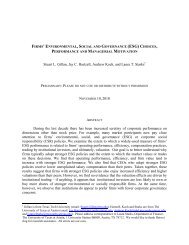Gaming the Float: How Managers Respond to EPS-based Incentives
Gaming the Float: How Managers Respond to EPS-based Incentives
Gaming the Float: How Managers Respond to EPS-based Incentives
You also want an ePaper? Increase the reach of your titles
YUMPU automatically turns print PDFs into web optimized ePapers that Google loves.
ealized but before <strong>the</strong>y are reported. We also expect that <strong>the</strong>se splits should more frequently be accretive<br />
than dilutive.<br />
3 Data and Results<br />
3.1 Data<br />
The sample analyzed in this study is compiled from four major databases.<br />
The primary data sample is<br />
ga<strong>the</strong>red from <strong>the</strong> quarterly CRSP/COMPUSTAT Merged database and combined with analyst forecast<br />
data obtained from I/B/E/S. Our sample starts in 1984 since we require 12 previous quarters of analyst<br />
forecasts in our main tests. Our sample ends in 2011. We include s<strong>to</strong>ck return data from CRSP. Only common<br />
s<strong>to</strong>ck with CRSP share code 10 or 11 are included. We merge in institutional ownership obtained from <strong>the</strong><br />
Thomson Reuters 13(f) institutional holdings database. For a subset of tests, we include compensation data<br />
from ExecuComp.<br />
To distinguish between changes in shares outstanding due <strong>to</strong> s<strong>to</strong>ck splits, repurchases, or equity issuances,<br />
we use distribution codes from CRSP. S<strong>to</strong>ck splits have a distribution code equal <strong>to</strong> 5523. In our sample,<br />
we assign a split <strong>to</strong> a fiscal quarter if <strong>the</strong> CRSP payment date (PAYDT) occurs after <strong>the</strong> prior earnings<br />
report date, but before <strong>the</strong> earnings report date as reported in COMPUSTAT. If <strong>the</strong> earnings report date is<br />
missing, a split is assigned <strong>to</strong> a fiscal quarter if it occurs within <strong>the</strong> fiscal quarter begin and end dates.<br />
A key prediction in our study centers on <strong>the</strong> link between shares outstanding and <strong>the</strong> volatility of earnings.<br />
We create three measures of earnings volatility. Net Income Volatility is calculated as <strong>the</strong> standard deviation<br />
of net income over <strong>the</strong> past 12 quarters.<br />
This directly measures <strong>the</strong> variance in net income, however it<br />
does not capture predictable, seasonal net income variation. Net Income Volatility - Naive Forecast is <strong>the</strong><br />
standard deviation of seasonally adjusted net income over <strong>the</strong> past 12 quarters. This proxy captures <strong>the</strong><br />
variance around a time-varying mean using a simple forecast for <strong>the</strong> mean <strong>based</strong> on seasonality and prior<br />
growth in net income. Net Income Volatility - Analysts Forecast is calculated as <strong>the</strong> standard deviation of<br />
(Net Income - median IBES forecasted earnings) over <strong>the</strong> past 12 quarters, where median IBES forecasted<br />
earnings is <strong>the</strong> median <strong>EPS</strong> forecast multiplied by shares outstanding. The benefit of this measure is that it<br />
captures actual earnings expectations in each period. <strong>How</strong>ever, <strong>the</strong> drawback is that it requires data from<br />
IBES which reduces <strong>the</strong> sample.<br />
[Insert Table 1 Here]<br />
13


